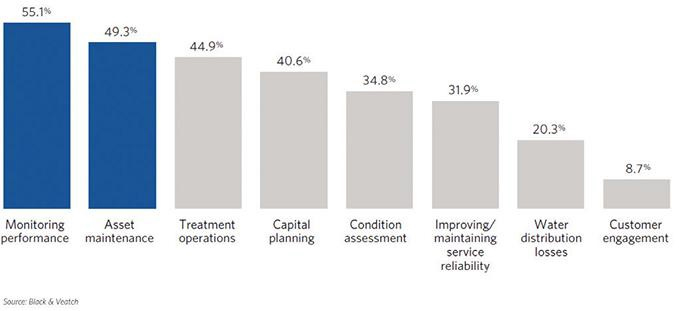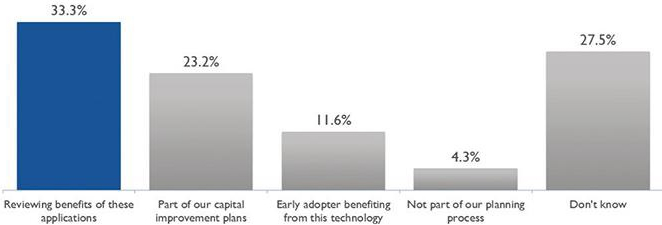How Big Is Big Data Among Water Utilities?
By Andrew Chastain-Howley
A survey of water utilities conducted by Black & Veatch reveals to what degree and how rapidly (or not) data analytics are being implemented in the real world.
We live in a world of smart phones, smart thermostats, and smart watches, so why not smart water? According to Black & Veatch’s “2018 Strategic Directions: Water Report,” roughly 70 percent of utilities are “very or somewhat interested” in smart water technology, which combines the power of automation, remote sensing technology, and control systems with advanced metering and data analytics to return actionable system intelligence.
Until now, cash-strapped water utilities have been stuck trying to balance priorities of time and resources. Riddled with assets that are reaching end-of-life — deteriorating pipes, failing pumps — utilities remain plagued by aging infrastructure. Now, in an effort to reduce operational costs and improve asset lifespans, water utilities are putting their data to work. But while smart water offers untold solutions, utilities are still working to understand how to gather, manage, and analyze this information in such a way that it can alleviate ongoing asset management challenges.
Embracing The Power Of Data
Smart water systems are on the rise. The “2017 Strategic Directions: Water Report” survey shows that last year, only 10 percent of survey respondents were using cloud-based software across all parts of their business. This year, that number has increased nearly threefold, to 28 percent.
Water utilities have always collected data, but historically that information was used to perform traditional tasks and rarely to assess asset health and predict failure.

Figure 1. What three operational areas do you feel that data analytics and automated monitoring will help improve most at your organization? (Select top three choices.)
Survey results suggest that, by embracing data analytics and automated monitoring, utilities would see the greatest impact on monitoring performance (as selected by 55 percent of respondents), asset maintenance (49 percent), and treatment operations (45 percent) — all areas where data can be leveraged to lower operating costs, optimize processes, and extend asset life (Figure 1).
Currently, more than half of utilities (59 percent) rely on remote data collection systems at all their pumping stations, while 43 percent have data collection at all their storage facilities (Figure 2).

Figure 2. Where do you currently have remote data collection on your network? (Select all that apply.)
While this growing adoption of data collection is encouraging, many utilities can still improve how they manage and analyze at both the tactical and strategic levels. New analytics tools are allowing water utilities to gain systems intelligence in a way that can unlock operational efficiencies — from guiding longrange strategy to enabling proactive maintenance opportunities. Data analytics are also transforming raw data into actionable intelligence — reducing water loss, preventing sewer overflows, and proactively identifying failing infrastructure.

Figure 3. Which data is your utility MOST in need of? (Select top three choices.)
But not all data is the same. When polled on what type of data they need most, 39 percent of utilities pointed to operations data (such as information on sewer maintenance and hydrant flushing), followed by supervisory control and data acquisition (SCADA) systems (36 percent) and customer maintenance and management systems (CMMS) (36 percent). To a lesser degree, they said laboratory information management systems (LIMS) and leakage data (Figure 3).
City of Lawrence Sees Benefit, Cost Savings
To allow for advanced asset evaluation, the City of Lawrence, KS, aggregates data from its water and wastewater plants and laboratory management department with water intelligence from the National Oceanic and Atmospheric Administration (NOAA) and the U.S. Geological Survey (USGS).

Figure 4. Where would you say you are on the spectrum for adapting smart technologies to your water development plan? (Select one.)
To do this, the city relies on Black & Veatch’s ASSET360®analytics platform, which consolidates, streamlines, and presents raw data from multiple sources into a single dashboard. The city sees a huge benefit in having all this data in one location, as it allows it to apply plotting and analysis across multiple data sets, giving it the ability to generate advanced visualizations and spot patterns and trends to make proactive, informed decisions.
For example, the city relies heavily on this capability during significant rain events that deposit high levels of inflow and infiltration into the sewer collection system. By streaming rainfall rates from NOAA, water levels from USGS, water quality from LIMS, and SCADA data that shows plant inlet flow rates through the dashboard, plant operators can get a 360-degree view of their systems. Viewing all this information simultaneously allows the city to accurately make predictions and operating decisions.
The Future Is Data Analytics
The benefits of smart water infrastructure are many. A new generation of innovative analytics tools is enabling water utilities to perform preventive maintenance on existing infrastructure, cutting maintenance costs, reducing water loss, and preventing sewer overflows. Data analytics are allowing water utilities to unlock operational efficiencies, improve revenue collection, gain system insights, and boost customer services. Lastly, data analytics can guide long-range planning and investment strategies.
But when it comes to putting systems in place, the industry still has a long way to go. According to the report survey, only 12 percent of survey respondents see themselves as early adopters benefiting from smart technologies, while 33 percent are reviewing the benefits, and 23 percent have these technologies as part of their long-term capital improvement plans (Figure 4).
To make the most of these investments, utility leaders should have a clear vision of their organizational goals and strategic objectives. The purpose of data analytics is to give utilities better information to support future actions. As the industry dives deeper into Big Data, advances in technology will be able to improve predictive capabilities, helping utilities anticipate failures in infrastructure and prioritize operations, maintenance, and capital efforts.
About The Author
 Andrew Chastain-Howley is a Director of Water Solutions for Atonix Digital, a Black & Veatch software subsidiary. He specializes in reducing water loss and managing water demand. He is based in Dallas, TX, and has 27 years of experience in the fields of data management and water system auditing and economics.
Andrew Chastain-Howley is a Director of Water Solutions for Atonix Digital, a Black & Veatch software subsidiary. He specializes in reducing water loss and managing water demand. He is based in Dallas, TX, and has 27 years of experience in the fields of data management and water system auditing and economics.
